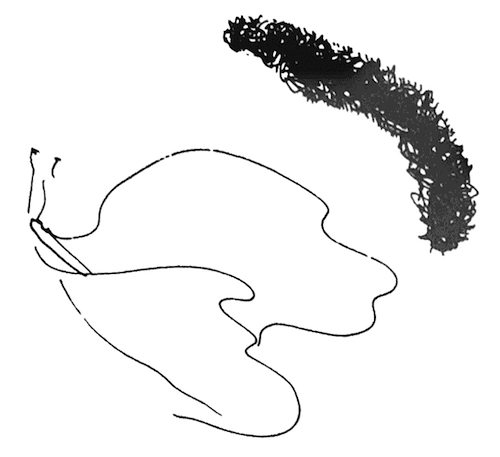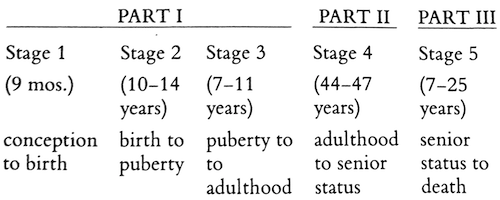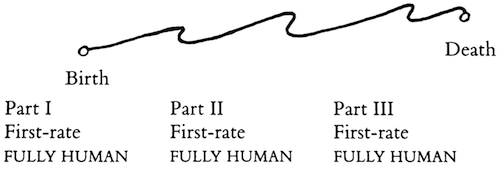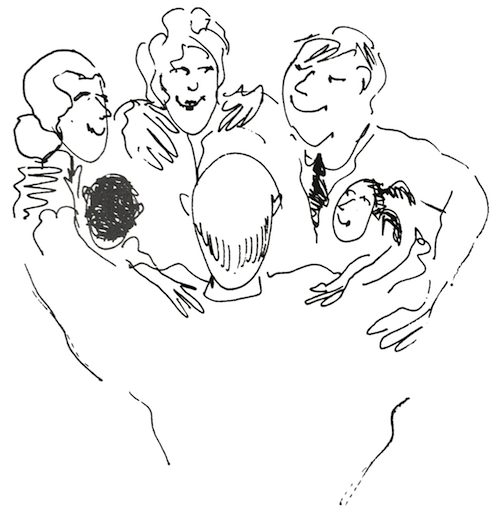19. The Life Cycle
To help you develop a perspective on your life, I want to show you images of the life cycle.
In gardening terms, we get planted, we sprout, grow a main stem, bud, flower and/ or fruit, and set a new form in motion. All of this happens for most people within approximately seventy to eighty years. To simplify matters, I will name our five stages, which cluster into three parts of life. These stages and parts simply remind us that we are different at different times of our lives. What is constant is our life force.
PART I
Stage 1. Conception to birth. This takes 9 months.
Stage 2. Birth to puberty. This takes 10 to 14 years.
Stage 3. Puberty to adulthood. This lasts 7 to 11 years.
The day we enter into our legal majority, we change our relationship with regard to dependency and responsibility. We are legally adults and responsible for everything we do. To be successful, we need to acquire——or to already have——the learnings that make that possible.
PART II
Stage 4. Adulthood to senior status. This stage lasts from 44
to 47 years and can be divided into young, middle-aged and older adults.
PART III
Stage 5. Senior status to death.
This too could be divided into stages: new, evolving, and
evolved.
Each part has specific growth tasks, responsibilities, and privileges connected with it. It also has a different form. For example, think of a caterpillar and a butterfly being the same energy in a different form.

Each part is a foundation for the next part as well as a link to it. When any part ends before completion——as when someone enters adult life still feeling like a child——the stages unfold out of sync, and the growth cycle becomes distorted. Energy is derailed and causes problems. From physicists, we learn that energy can never be destroyed; it only changes form. Therefore, the energy one uses for a slap can be used instead for hugging. This again raises a very significant question: shall we use our energy for growth, health, and happiness for everyone, or sickness, despair, and destructiveness? Finding out and learning all the ways that we can be constructive means taking a careful look at what we are now doing, then being willing to let go of those ways that defeat and limit us.
Certain learnings are universally necessary to become more fully human. These need to take place at every stage and every part of our life in some form, in every human being, starting with the first stage, infancy. I submit this list of learnings that constitute necessary personal competence.
Differentiation: Distinguishing between you and me.
Relationships: Knowing how to connect to you and others.
Autonomy: Relying on myself, separate and distinct from anyone else.
Self-esteem: Feeling worthy about myself.
Power: Using my energy to initiate and guide my behavior.
Productivity: Manifesting my competence.
Loving: Being compassionate, accepting of others, and giving and receiving affection.
The development of each stage will determine the new form that the universal learnings will take. For example, one would not teach personal competence to a child by demanding that she or he become skillful at driving a car. The child’s level of competence could be better developed by learning to use a spoon. Car driving is a competency more appropriate for older teenagers.
The following shows the stages in a life span.

How we think about and approach these stages determines the outcomes of our lives. The approach shown in this next figure is based on the dominant-submissive pair model. With this we come into the world helpless and go out useless.

In terms of power and accomplishment, only the adult phase has any positive value in this figure. Pre-adult is too young, and post-adult is too old. This leaves two parts of life essentially devalued, potentially unacceptable, thoroughly disenfranchised, and alienated.
With this picture, it is easy to see how adolescence becomes so frustrating, and old age so abhorrent, to many people. The life line is disempowered at two major points: at the beginning and at the end. The only acceptable place is in the middle. Power is conferred only on adults. It is denied to youth and seniors.
Having spent the first eighteen to twenty-one years learning how to be “too young to,” the night before our twenty-first birthday can be a very long night. Among other things, we have to learn how to have high self-esteem, how to use power constructively, and how to make wise choices and decisions in order to handle what faces us in this new stage. This is a big order for a night’s sleep.
Of course, we don’t accomplish this in one night. We wake up on our birthday pretty much the same as when we went to sleep. Many of the skills and attitudes we need to negotiate the adult stage successfully still have to be learned. And we struggle to do so.
Probably the greatest reason for finding ways to help adolescents feel valued, capable, and effective is to give them the courage, judgment, healthy self-esteem, and other necessary tools with which to meet the responsibilities of their adulthood. Unfortunately, many children are born to parents who have not yet learned what they need to teach. After all, adults can only teach their children what they know. So they continue passing on old attitudes and themes, often mistaking them as innate instead of learned.
By this time the parents have probably arrived at the end of their adult stage. Now they have to look at their impending senior status, wherein they will be “too old to.” This change in status often coincides with menopause and retirement, and is responsible for much depression. Fear sometimes takes over and renders many older persons vulnerable to physical, social, and mental disease.
Interestingly, adolescents respond similarly to their new status. They are more likely than older people to engage in aggression and violence, however. Their abundant energy may have no healthy place to express itself, and their self-worth is low.
Almost all of our current educational, medical, social, and psychological practices are based on this dominant-submissive model, categorized by age instead of personhood. This needs to be reevaluated so that each person in each phase of each stage can fully be a human being. The figure below depicts a model that offers very different and hopeful outcomes. The stages and parts of life are the same; however, the approach differs vastly.

In this fully human model, each person is always in the right place at every stage. We still come into the world helpless, yet we go out gloriously at a high point in our development. This model’s relationships are based not on power but on healthy self-worth, equality of value, love, and behavior that reflects personal and social responsibility.
In this model, we approach life with the idea of making every stage first-rate. Each stage reveals a marvel. It expresses the magic of growth. Each stage is treated as a time to be enjoyed, learned from, given to, taken from, and looked at as a whole within itself. Remembering that people are live beings in constant movement, we treat them accordingly.
By the time we reach senior status, we have had so much experience in being whole that our later years are yet another arena in which to develop new possibilities. Won’t it be great when, at the sunset of our lives, we can say we lived each part fully, deepening and broadening our understanding and appreciation of ourselves as we went along?
The modern challenge is to empower ourselves so that we can be models and leaders of this process for ourselves and others for each stage of our lives.
